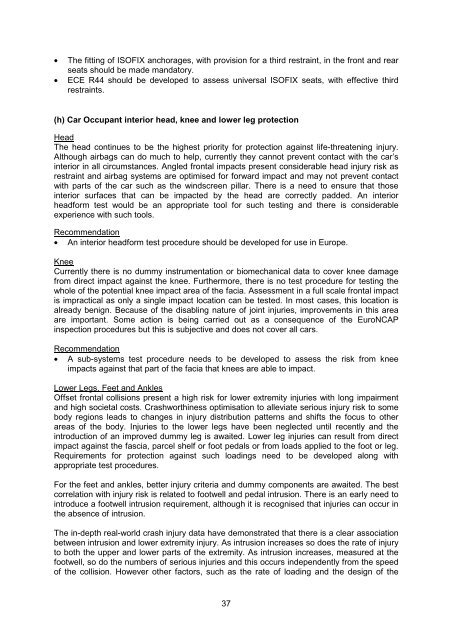PRIORITIES FOR EU MOTOR VEHICLE SAFETY DESIGN
priorities for eu motor vehicle safety design - ETSC
priorities for eu motor vehicle safety design - ETSC
Create successful ePaper yourself
Turn your PDF publications into a flip-book with our unique Google optimized e-Paper software.
• The fitting of ISOFIX anchorages, with provision for a third restraint, in the front and rear<br />
seats should be made mandatory.<br />
• ECE R44 should be developed to assess universal ISOFIX seats, with effective third<br />
restraints.<br />
(h) Car Occupant interior head, knee and lower leg protection<br />
Head<br />
The head continues to be the highest priority for protection against life-threatening injury.<br />
Although airbags can do much to help, currently they cannot prevent contact with the car’s<br />
interior in all circumstances. Angled frontal impacts present considerable head injury risk as<br />
restraint and airbag systems are optimised for forward impact and may not prevent contact<br />
with parts of the car such as the windscreen pillar. There is a need to ensure that those<br />
interior surfaces that can be impacted by the head are correctly padded. An interior<br />
headform test would be an appropriate tool for such testing and there is considerable<br />
experience with such tools.<br />
Recommendation<br />
• An interior headform test procedure should be developed for use in Europe.<br />
Knee<br />
Currently there is no dummy instrumentation or biomechanical data to cover knee damage<br />
from direct impact against the knee. Furthermore, there is no test procedure for testing the<br />
whole of the potential knee impact area of the facia. Assessment in a full scale frontal impact<br />
is impractical as only a single impact location can be tested. In most cases, this location is<br />
already benign. Because of the disabling nature of joint injuries, improvements in this area<br />
are important. Some action is being carried out as a consequence of the EuroNCAP<br />
inspection procedures but this is subjective and does not cover all cars.<br />
Recommendation<br />
• A sub-systems test procedure needs to be developed to assess the risk from knee<br />
impacts against that part of the facia that knees are able to impact.<br />
Lower Legs, Feet and Ankles<br />
Offset frontal collisions present a high risk for lower extremity injuries with long impairment<br />
and high societal costs. Crashworthiness optimisation to alleviate serious injury risk to some<br />
body regions leads to changes in injury distribution patterns and shifts the focus to other<br />
areas of the body. Injuries to the lower legs have been neglected until recently and the<br />
introduction of an improved dummy leg is awaited. Lower leg injuries can result from direct<br />
impact against the fascia, parcel shelf or foot pedals or from loads applied to the foot or leg.<br />
Requirements for protection against such loadings need to be developed along with<br />
appropriate test procedures.<br />
For the feet and ankles, better injury criteria and dummy components are awaited. The best<br />
correlation with injury risk is related to footwell and pedal intrusion. There is an early need to<br />
introduce a footwell intrusion requirement, although it is recognised that injuries can occur in<br />
the absence of intrusion.<br />
The in-depth real-world crash injury data have demonstrated that there is a clear association<br />
between intrusion and lower extremity injury. As intrusion increases so does the rate of injury<br />
to both the upper and lower parts of the extremity. As intrusion increases, measured at the<br />
footwell, so do the numbers of serious injuries and this occurs independently from the speed<br />
of the collision. However other factors, such as the rate of loading and the design of the<br />
37



